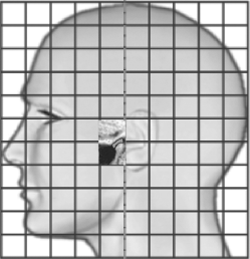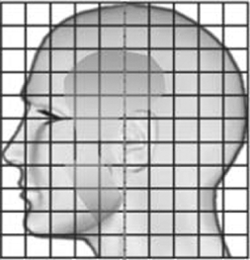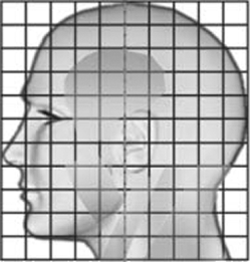Orofacial Pain
Alexandre F. M. DaSilva
Martin Andrew Acquadro
Pain diminishes or constrains man’s power of activity, in other words, diminishes or constrains the efforts wherewith he endeavours to persist in his own being; therefore it is contrary to the said endeavour: thus all the endeavours of a man affected by pain are directed to removing that pain.
—Benedict de Spinoza, 1632–1677, in Ethics, 1677
Many medical, dental, and other health specialists are involved in the management of orofacial pain, often exposing the patient to a variety of referrals and interventions. Many times orofacial pain is the result of a complex process. The particular patient’s pain problem is then approached from the bias of one particular specialty, when a multidiscipline or multidimensional approach may provide a more comprehensive treatment. The multiple specialists involved in the treatment of orofacial pain, the rich synaptic connections with the limbic and autonomic systems, the social function of the face, and the highly visible and expressive nature of the face together make orofacial pain unique.
I. NEUROANATOMY AND NEUROPHYSIOLOGY
Tactile, thermal, and painful stimuli are transduced by specialized end organs or free nerve endings in the skin. At the level of the brainstem, the trigeminal sensory fibers synapse with second-order neurons in the trigeminal brainstem nuclear complex, which ascends through specific pathways. One ascending pathway is the lemniscal trigeminothalamic pathway, transmitting tactile, thermal, and some proprioceptive and noxious information. The other ascending pathway is the ventral trigeminothalamic pathway, subdivided into: (a) the paleotrigeminothalamic tract, which
mainly carries the affective-motivational aspects of pain (e.g., unpleasantness) processed subsequently by cortical areas such as the anterior cingulated cortex, insula, and prefrontal cortex; and (b) the neotrigeminothalamic tract, which mostly conveys the sensory discriminative aspects of pain (e.g., location, size) and is processed by the somatosensory cortex and anterior insular cortex.
mainly carries the affective-motivational aspects of pain (e.g., unpleasantness) processed subsequently by cortical areas such as the anterior cingulated cortex, insula, and prefrontal cortex; and (b) the neotrigeminothalamic tract, which mostly conveys the sensory discriminative aspects of pain (e.g., location, size) and is processed by the somatosensory cortex and anterior insular cortex.
Clinical features of orofacial pain such as referral patterns, autonomic signs, interference with sleep-wake patterns, and the effect of emotional stimulation can be better understood in the context of the rich area of neural interchange described in the preceding text. Peripherally, many facial structures are innervated by branches of multiple nerves producing pathways for referred pain. For example, the periauricular area receives sensory innervation from cranial nerves V, VII, IX, and X, and from cervical roots C2 and C3, with referral patterns to the neck, eye, and face.
II. PSYCHOLOGICAL ASPECTS
The face and the treatment of facial pain are the most visible examples of the biophysical psychosocial model of pain. The face is a window through which we view the world and, in turn, by which we are viewed. Facial pain is therefore a highly visible form of pain, etched on the most expressive area of the body for all to see. This visibility is emphasized by the term “tic douloureux” given to trigeminal neuralgia. The resulting lack of privacy encountered by people who have facial pain compounds the increased rates of anxiety and depression found in many chronic pain states. In addition, people with facial pain may be perceived as angry, sad, or socially negative because of the effects of pain on their facial expression. Psychological factors present before the onset of pain (primary) and because of the pain (secondary) are important in the patient’s perception of pain. Modification of the psychological factors can modulate the pain experience. Treatment of anxiety, depression, and sleep disruption should always be undertaken in conjunction with treatment of the primary pain source.
III. TEMPOROMANDIBULAR JOINT ARTICULAR DISORDERS, TEMPOROMANDIBULAR MUSCLE DISORDERS, AND MYOFASCIAL PAIN DISORDERS
(i) Diagnostic Features
It is useful to distinguish true temporomandibular joint (TMJ) articular disorders, temporomandibular muscle disorders (TMD) (i.e., dysfunction and pain of the muscles of mastication), and myofascial pain disorders originating in muscles other that those involved directly with mastication. When it involves the face, the source of pain may be the head and facial muscles, or muscles of mastication. Because of the neuroanatomy described in the preceding text, muscles of the shoulders and neck can refer pain to the face, sinuses, or head. Just as there are involuntary mechanical and muscle compensation in the lower back, hips, and knees associated with lower back and extremity musculoskeletal pathologies, so there are instigating, contributing, and perpetuating factors of myofascial pain of the head, neck, and orofacial areas from outside these areas (see Table 1).
Table 1. Temporomandibular (TM) disorders | |||||||||||||||||||||||||||||||||
|---|---|---|---|---|---|---|---|---|---|---|---|---|---|---|---|---|---|---|---|---|---|---|---|---|---|---|---|---|---|---|---|---|---|
| |||||||||||||||||||||||||||||||||
(ii) Clinical Characteristics
TMJ ARTICULAR DISORDERS.
True pathologic derangement of the TMJ as the isolated cause for pain is not common. TMJ damage can be the result of direct trauma, wear and tear from chronic pathologic occlusal forces, and overextension of jaw movements. Some other conditions also affect the TMJ, such as congenital and developmental disorders (e.g., hyperplasia and neoplasia), inflammatory disorders (e.g., arthritis), osteoarthritis, and ankylosis. Just as one can find magnetic resonance imaging (MRI) abnormalities of the lumbar spine in patients who are asymptomatic, so can one find evident TMJ pathology in asymptomatic individuals. Many subjects have an “abnormal” TMJ, which “clicks” or has a deviation or displacement during opening and closing of the mandible, but few have accompanying pain. However, if the patient complains of a chronic TMJ dysfunction with pain, he/she deserves assessment by an orofacial pain specialist.
TEMPOROMANDIBULAR MUSCLE DISORDER.
TM muscle disorder is characterized by dull aching pain exacerbated by mandibular function, muscle tenderness in one or more masticatory muscles, and often a decreased mandibular range of motion. The pain is commonly described as a dull ache exacerbated by chewing, fluctuating in intensity daily, and associated with remissions lasting months. A range of terms exist, with a variety of classifications and subclassifications. These classifications include myofascial dysfunction, myositis, myalgia, myospasm, and myofibrotic contracture. The absence of clinical features referable to the TMJ and the presence of muscle tenderness distinguish this from primary TMJ articular disorders, although secondary TMJ changes and joint remodeling can occur.
MYOFASCIAL PAIN DYSFUNCTION.
Dysfunction of the muscles of the shoulders, neck, head, and face is relatively common in the general population and can aggravate headaches, sinus area pain, and orofacial pain. Fibromyalgia is a type of myofascial dysfunction distinguished as a systemic disease characterized by muscle pain and tenderness in multiple body quadrants. It can be exacerbated by stress, anxiety, and weather changes, and accompanied by a variety of generalized symptoms such as fatigue, morning stiffness, and headache. The patient with fibromyalgia may initially present with facial pain and tenderness in the muscles of mastication; it is important to question patients for systemic features and not focus simply on the local complaint. Other systemic myofascial disorders are polymyalgia, lupus erythematosus, polymyositis, and dermatomyosits. A more common complaint of generalized pain, although usually limited to the upper quadrant of the body, is the direct trauma and whiplash injury to muscles of the neck and shoulders.
(iii) Epidemiology
Myofascial pain disorders occur predominantly in women. Masticatory myalgia and myositis occur in younger women (late teens to 40 years), whereas fibromyalgia most commonly presents in older women (45 to 55 years). The prevalence of TMD ranges from 6% to 12% of the North American population. Patients complaining of TMD pain are likely to be women, with an average age of 40 (±16) years. Direct trauma to facial muscles producing pain is notable for its greater frequency in men.
(iv) Diagnostic Evaluation, Imaging Studies, and Laboratory Tests
Diagnostic evaluation includes a careful and thorough history and physical examination of the integrity and function of the head and neck structures, with special attention to the TMJ complex (e.g., masticatory muscles, articular structures), and cranial and cervical nerves. Evaluation should include a review for a history of headaches, surgeries, trauma, and psychosocial events and stressors. A review of daily activities along with posture, repetitive movements, habits, and sleep patterns should be included. A history of parafunctional habits (clenching and grinding of teeth), awakening in the morning with sore jaw muscles, clicking or grating noises when opening the mouth, and recent or extensive dental work should be elicited. An examination of the oral cavity for any lesions that may cause a reflex avoidance pattern, pain on extreme opening of the mandible, and abnormal bite should be checked. Teeth sensitivity, painful muscles, and tender points should be examined.
MRI and CT (computerized tomography) scan of the TMJ may be necessary to evaluate possible advanced degenerative pathologies or tumors. However, radiographs frequently report abnormalities of the TMJ disk position in asymptomatic joints that do not need treatment. Therefore, imaging exams of the TMJ, other than panoramic radiography, should only be requested in treatment-resistant chronic pain, unusual pain patterns, and sudden changes in the occlusion. There are no imaging techniques for myofascial pain disorders that are useful in diagnosis or management. Consideration of other rheumatologic or immunologic diagnoses by history and physical examination will dictate additional studies and referral to the appropriate specialist.
(v) Treatment
PHYSICAL THERAPY.
A patient diagnosed with TM disorders may benefit from complete evaluation and treatment by a physical therapist. The treatment program may include stretching, strengthening, and endurance exercises, transcutaneous electrical nerve stimulation (TENS), ultrasound, thermal application, and mobilization (joint and soft tissue). The patient should follow an active exercise program at home with guidance from a physical therapist.
PHARMACOLOGIC THERAPY.
Pharmacologic therapy includes judicious use of nonsteroidal antiinflammatory drugs (NSAIDs), very selective use of tricyclic antidepressants (TCAs), and selective use of anticonvulsants, other analgesics, muscle relaxants, anxiolytics, and, very rarely, opioids. NSAIDs may be used for both their analgesic and antiinflammatory properties. There is marked interpatient variability in response to different agents, necessitating trials of agents until the optimal response is obtained. Because of the ceiling effect of NSAIDs and gastrointestinal and renal toxicity issues, increasing doses, and time of use beyond the recommended maximum is not useful. NSAIDs are of no proven value in the long-term management of TMJ pain, although large doses may provide short-term relief. Patients who are unable to tolerate NSAIDs may use tramadol hydrochloride, a weak and nonaddicting μ-agonist, at a dosage of 50 to 100 mg
every 6 hours, as needed. Short-term use of centrally acting muscle relaxants includes cyclobenzapine (Flexeril) and carisoprodol (Soma). These agents decrease excess electromyogram (EMG) activity and muscle spasm. The tertiary amine amitriptyline, having greater anticholinergic effects than the secondary amines desipramine and nortriptyline, in low doses, may improve sleep and may act as indirect analgesics by inhibiting serotonin and norepinephrine reuptake. Benzodiazepines, such as diazepam, decrease muscle spasm, improve sleep, and show anxiolytic activity. A dosage of 0.5 mg once or twice a day is useful in initial therapy. Prolonged use of benzodiazepines should be avoided because of their addiction potential. In patients requiring prolonged treatment of anxiety symptoms, buspirone (Buspar) 5 mg three times daily is effective with little addiction potential, but has no muscle relaxant effects.
every 6 hours, as needed. Short-term use of centrally acting muscle relaxants includes cyclobenzapine (Flexeril) and carisoprodol (Soma). These agents decrease excess electromyogram (EMG) activity and muscle spasm. The tertiary amine amitriptyline, having greater anticholinergic effects than the secondary amines desipramine and nortriptyline, in low doses, may improve sleep and may act as indirect analgesics by inhibiting serotonin and norepinephrine reuptake. Benzodiazepines, such as diazepam, decrease muscle spasm, improve sleep, and show anxiolytic activity. A dosage of 0.5 mg once or twice a day is useful in initial therapy. Prolonged use of benzodiazepines should be avoided because of their addiction potential. In patients requiring prolonged treatment of anxiety symptoms, buspirone (Buspar) 5 mg three times daily is effective with little addiction potential, but has no muscle relaxant effects.
TRIGGER POINT INJECTIONS, BOTULINUM TOXIN INJECTIONS, AND PHYSICAL THERAPY.
Pressure on active trigger points (TPs) causes acute pain, and produces spasms when the muscle is used, decreasing the range of motion. Trigger points can be localized by pressure and then inactivated by the topical application of vapocoolant spray (dichlorodifluoromethane), allowing stretching exercises to restore muscle mobility. The injection of local anesthetics in the TP can be performed with subsequent physical therapy. This injection provides prolonged analgesia, allowing the patient a pain-free period to commence physical therapy, with subsequent use of vapocoolants and stretching exercises at home. However, the pain relief may last much longer than the anesthetic effect. Corticosteroids, such as triamcinolone acetonide (Kenalog) can be added to the mixture. Steroid injections should not be repeated any sooner than six weeks, as a peau d’orange cosmetic defect may occur.
Botulinum toxin (BTX) injection is proven to be an excellent therapeutic tool for the treatment of myofascial pain. First indicated for involuntary muscle contraction disorders (e.g., blepharospasm and dystonia), BTX seems to disrupt the membrane- fusion and exocytosis of acetylcholine-containing vesicles into the extracellular milieu. The effects are reduction of muscular tone, contractility, and graded chemical denervation in the muscular area injected. Botulinum toxin may also reduce pain, and clinical reports support its use in some chronic pain diseases, including primary headaches (e.g., tension-type headache), inflammatory pain, and even some selected cases of trigeminal, and postsurgical and posttraumatic neuropathic pain. It appears that more injections with lower units per injection over an area of pain are more effective than a single large dose injection. However, randomized control clinical studies are lacking. The beneficial effect of a BTX injection can last for an average of 4 months and may be repeated if indicated. Advantages include no systemic side effects, but the application requires a practitioner skilled in the use of BTX in the head and neck, to avoid unanticipated facial and other head and neck muscular weakness, transient facial deformity, or severe respiratory, masticatory, and swallowing compromise.
PSYCHOLOGICAL THERAPY.
DENTAL TREATMENT.
Advocates of splint therapy suggest that it temporarily equilibrates bite occlusion, mechanically unloading the TMJ and limiting masticatory muscle activity, thereby decreasing symptoms of TM disorders. Occlusal appliance therapy seems to be beneficial in cases of myofascial pain, even when there are no signs of parafunctional habits (e.g., bruxism). Missing teeth and dental malocclusions have an inconsistent relation to TM disorders. In extreme occlusal discrepancies, oral rehabilitation (e.g., orthodontic and prosthodontic treatments) may improve masticatory function, without guarantee of pain relief.
TEMPOROMANDIBULAR JOINT SURGERY.
Open surgery of the TMJ is associated with high morbidity and a lack of efficacy, unless proper and careful patient selection is utilized by an experienced oral and maxillofacial surgeon. More conservative procedures, such as arthrocenthesis and arthroscopic surgeries, should be considered first.
SUGGESTED TEMPOROMANDIBULAR MUSCLE DISORDER HOME TREATMENT REGIMEN.
Temporary rest of the TMJ is sometimes helpful. Liquid and soft diet is instituted, and gum chewing is stopped. Wide, uncontrolled opening of the jaw is discouraged. Yawning, coughing, laughing, and the eating of large sandwiches are kept to a minimum. A hand or fist placed under the chin during wide mouth opening helps to hold the jaw in place. Heat or ice gel pack therapy can be useful; a heating pad, warm face cloth, or warm water bottle placed to the sides of the jaw and TMJ area will have a soothing and relaxing effect on the muscles. Alternatively, an ice gel pack for 10 to 20 minutes should be tried. Gentle midline opening and closing exercises of the mandible help retrain and relax muscles. Use of a vapocoolant spray also may be helpful in reducing movement-induced pain, so that exercises designed to improve joint mobility can be tolerated. Judicious use of NSAIDs may also help. Consider acetaminophen in patients with NSAID sensitivity, or coxibs in patients with a serious risk for bleeding or other relevant history.
IV. ODONTOGENIC PAIN
(i) Diagnostic Features
Because of the rich innervation of the mouth, pain resulting from tooth or periodontal disease can present with numerous features including local pain, headache, or eye symptoms. Differential diagnosis includes trigeminal neuropathic pain, sinus disease, and primary headaches (e.g., cluster headache and migraine) (see Table 2).
(ii) Epidemiology
Dental disease is common in both male and female adults and children of all ages.
(iii) Diagnostic Evaluation, Imaging Studies, and Laboratory Tests
During the history and clinical examination, odontogenic pain must be adequately assessed. Aggravating and relieving factors,




Stay updated, free articles. Join our Telegram channel

Full access? Get Clinical Tree










